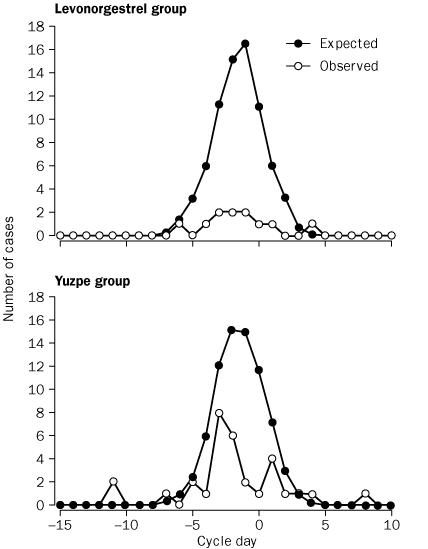Relative efficacy of the Yuzpe and levonorgestrel-only methods of post-coital birth control
Based upon well-proven fertility data, the probability of conception can be calculated in relationship to the day of intercourse. (1) Using these and other data, researchers have tested the Yuzpe method of postcoital birth control alone, and against the levonorgestrel-only method.
For the Yuzpe method only, Ellertson and co-workers (1995) have reported that there was a 75% reduction in the expected pregnancy rate. (2) Trussell (1998) reported effectiveness estimates from seven separate studies ranging from 44.2% to 88.7%. (3) Similar figures were published the following year. (4)
In 1998, the World Health Organization published the results of the Task Force on Postovulatory Methods of Fertility Regulation, which, importantly, compared the Yuzpe method with the levonorgestrel-only method (previously described). The foremost finding from this study was that the levonorgestrel regimen prevented 85% of the expected pregnancies, whereas the Yuzpe regimen prevented 57% of expected pregnancies. (5) The following graph from that paper shows the expected versus the observed pregnancy rates both the two methods of post-coital birth control.

WHO study, 1998, p.431
Whilst some researchers have criticised the magnitude of 'success' of the above cited levonorgestrel (LNG) regime(6), another WHO multi-centre, multi-national trial involving 4071 women reported that when LNG was taken as the split dose, 12 hours apart, the expected pregnancy rate was reduced by 77%. When both LNG tablets were taken simultaneously, the expected pregnancy rate was reduced by 82%.(7) (WHO, 2002)
This evidence makes the abortifacient action of either drug regime of post-intercourse birth control conspicuous, and is confirmed by Dr Caroline Wellbery. "It is estimated that if 100 women have a single episode of unprotected intercourse without particular attention to the timing of the menstrual cycle, 8 of them will become pregnant. With EC (in the form of combination pills), only two women will become pregnant. Progestin-only pills (i.e., levonorgestrel) regimens are estimated to be even more effective." (8) Note the erroneous use of the terms 'pregnant' and EC (i.e., emergency 'contraception') in this citation.
This high abortion rate is not unexpected given the extraordinary doses of levonorgestrel ingested - the levonorgestrel-only EC dose is equal to taking 40 to 50 standard once-a-daily progesterone-only birth control pills.
Ironically, Gy. Thaler of Gedeon Richer Ltd (Hungry), the manufacturer of Postinor™ (levonorgestrel 0.75mg) has unwittingly acknowledged the seriousness of this debate, by noting that the promotion and use of the morning-after pill "involves ethical and moral questions." (9)
(1) Wilcox AJ, Weinberg CR, Baird DD op.cit. .
(2) Ellertson C, Winikoff B, Armstrong E et al. Expanding access to emergency contraception in developing countries. Stud Fam Planning 1995; 26,5:251-263
(3) Trussell J, Rodriquez G, Ellertson C. op.cit., 1998, p.363
(4) Trussell J, Raymond E. op.cit., 1999, p.147
(5) Task Force on Postovulatory Methods of Fertility Regulation. op.cit.,1998; 352:428-433
(6) Glasier AF, Cameron ST, Fine PM et al. Ulipristal acetate versus levonorgestrel for emergency contraception: a randomised non-inferiority trial and meta-analysis. Lancet. 2010;375:555-562
(7) Von Hertzen H, Piaggio G, Ding J et al. Low dose mifepristone and two regimens of levonorgestrel for emergency contraception: a WHO multicentre randomised trial. Lancet. 2002;360:1803-1810
(8) Wellbery, op.cit., p.643
(9) Thaler Gy. Collaboration with academia in the development of post ovulatory methods. Int J Gynec Obstet 1999; 67:S77-S83
